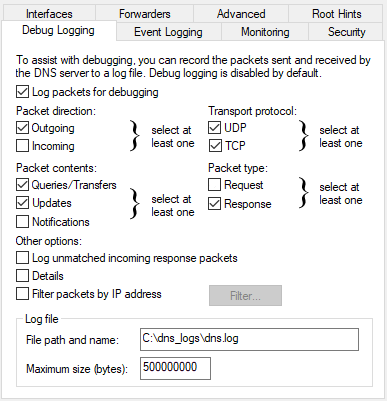| SamurAI [Local] Collector | SamurAI [Cloud] Collector |
|---|---|
Use this document to install and configure the Filebeat agent to send Microsoft DNS Server logs to Samurai using the Samurai Local Collector deployed in your network.
To complete this Integration you will need to:
- Ensure correct network connectivity
- Download & Install Filebeat
- Configure & Enable Microsoft DNS Server Debug Logging
- Configure & Start Filebeat
Ensure correct network connectivity
You must ensure the following connectivity requirements are fulfilled:
| Source | Destination | Ports | Description |
|---|---|---|---|
| Microsoft DNS Server Host | Samurai Local Collector | TCP/5044 | For log transmission |
Download & Install Filebeat
Perform the steps outlined in Step 1: Install Filebeat as per the vendor documentation.
Configure & Enable Microsoft DNS Server Debug Logging
Follow the steps outlined in To select and enable debug logging options on the DNS server as per the vendor documentation.
Configure Packet direction & Packet Contents*.*
- Keep default configuration or follow the minimum requirement below.
- Minimum requirement is to enable logging for Outgoing Response.

Figure 1 – Example of default configuration once “Log packets for debugging” has been enabled.
Configure an appropriate log location and name of the log file as well as a suitable Maximum Size (bytes) according to your system needs.
Note down the file path that has been configured, this will be used later in the section Configure & Start Filebeat.
Configure & Start Filebeat
- Access the Filebeat installation folder and open and edit the file filebeat.yml.
- Modify the below template by replacing the section IP_OF_LOCAL_COLLECTOR with the IP address of the Samurai Local Collector.
- Modify the paths section of the template to use the path that was configured for the DNS Server debug log file location from Configure & Enable Microsoft DNS Server Debug Logging.
# ============================== Filebeat inputs ===============================
filebeat.inputs:
- type: filestream
id: win_dns_server
enabled: true
paths:
- 'C:\dns_logs\*'
include_lines: ['^\d{1,4}.\d{1,2}.\d{1,4}\s.*?$']
tags: [win_dns_server]
# ------------------------------ Logstash Output -------------------------------
output.logstash:
hosts: ["IP_OF_LOCAL_COLLECTOR:5044"]
- Replace the default configuration of filebeat.yml with the modified template and save the file.
- Perform the steps outlined in Step 5: Start Filebeat as per the vendor documentation to start the service.
Our Integration guide was accurate at the time of writing but vendors change things frequently! If you find errors or anything is outdated, let us know by raising a request in the SamurAI MDR Portal and we shall get it updated.